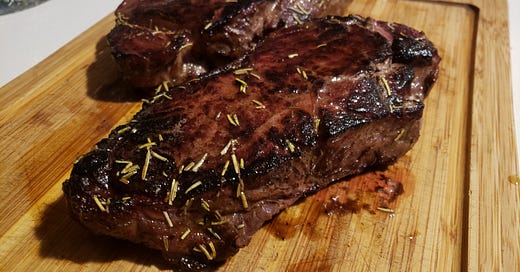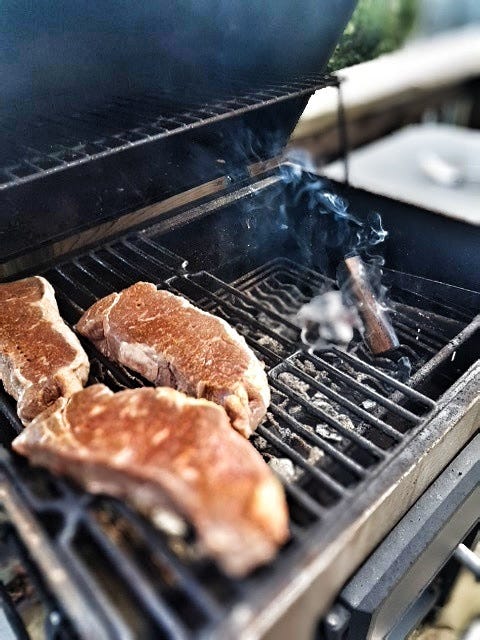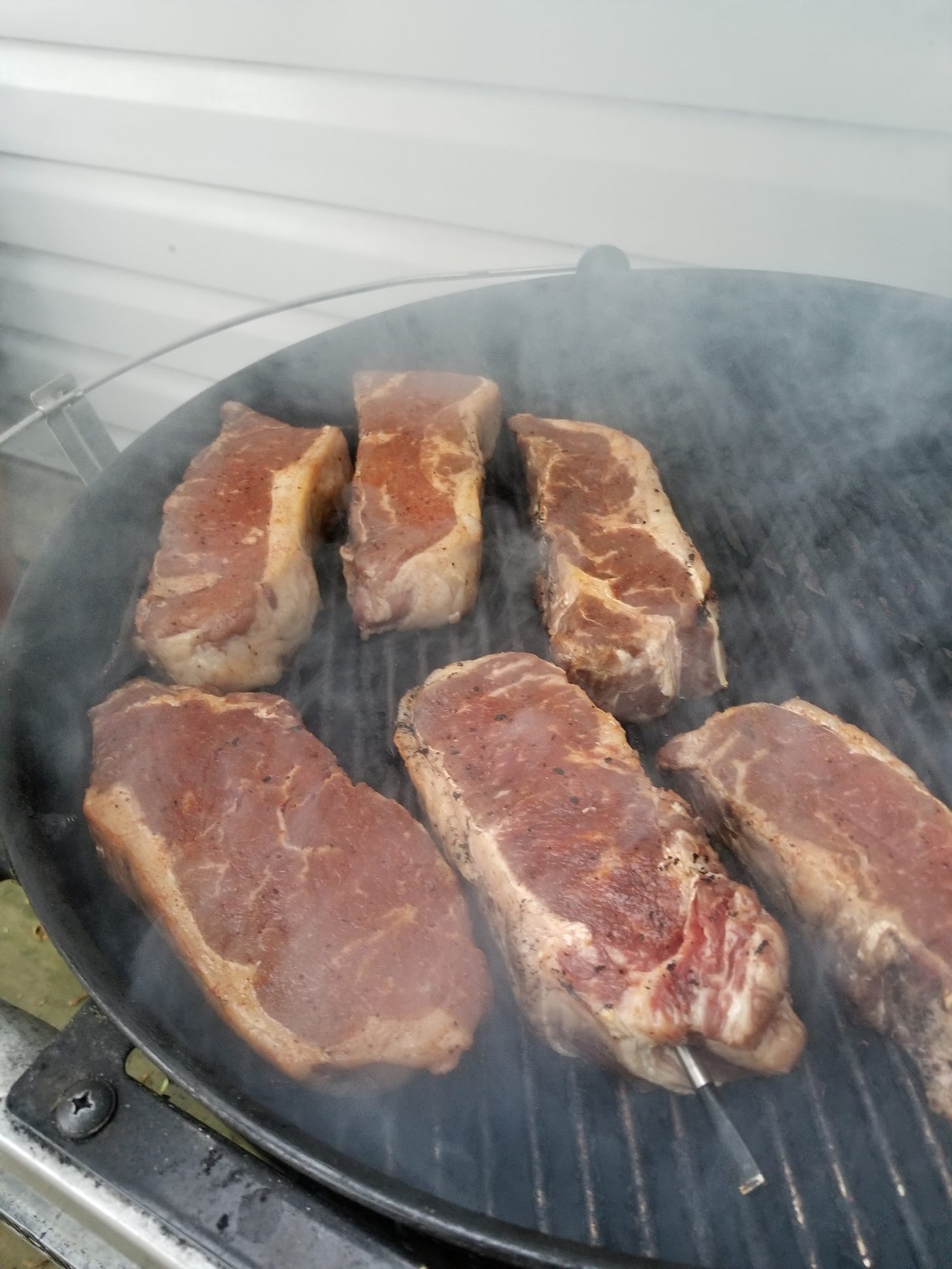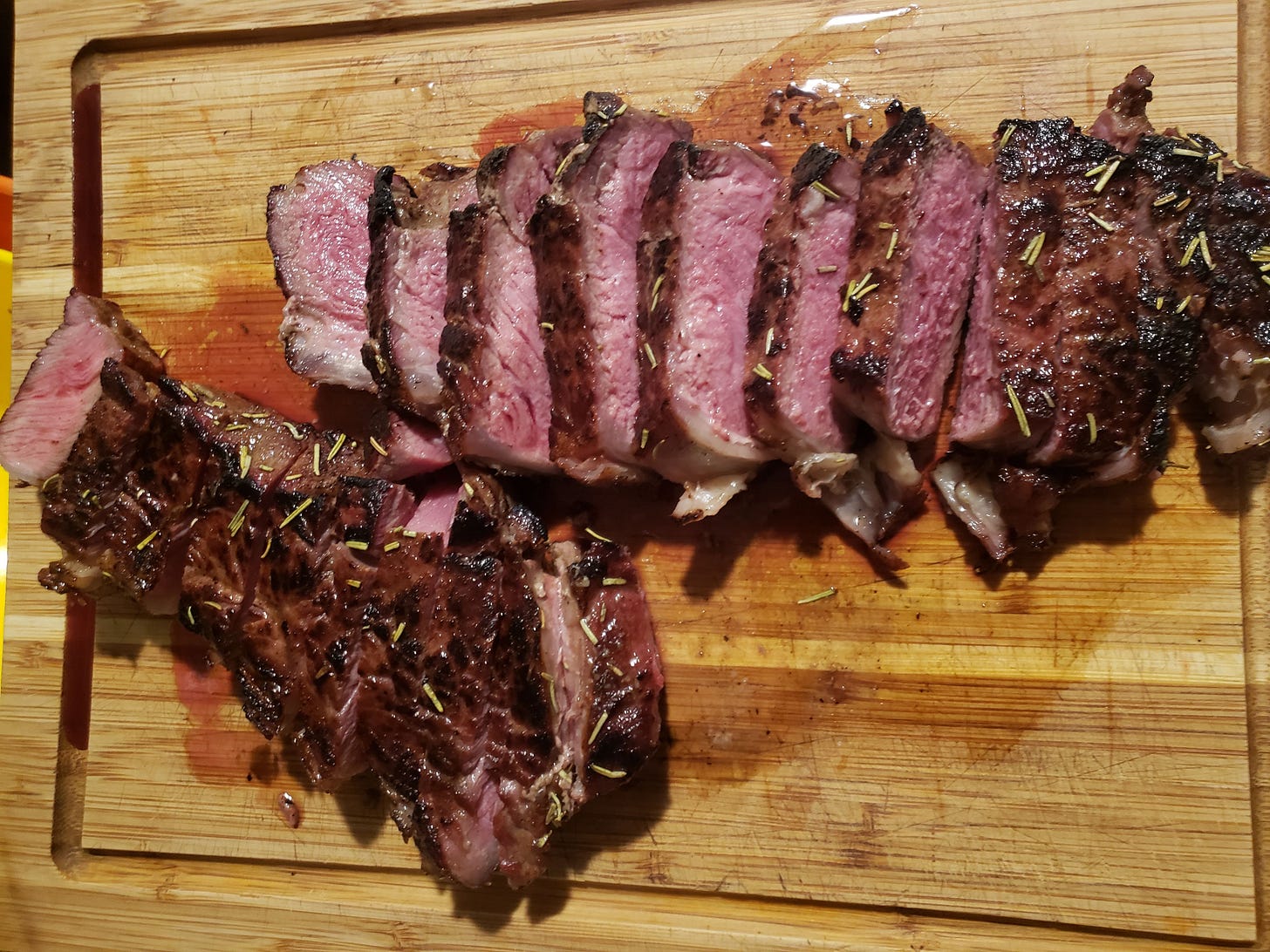Reverse Seared Strip Loins
The only way to cook steaks....less stressful than other methods and just better
I call the method sous la fumée, after Sous Vide, which means “under vacuum”…. First an explanation of what Sous Vide is, then my method.
Sous Vide: where you cook meat in a vacuum bag under a hot water bath to a specific temperature, then fast sear. The great thing about this is that you can leisurely take meat to an exact uniform temperature from edge to edge…hold it at that temperature for as long as you want, then sear for external color and flavor just before serving. (Great for restaurants) The long slow cooking also tenderizes of course. The benefits: very precise control over temperature, low stress getting to perfect temp, cook a bunch of steaks identically vs different pieces being at different temps at different times. Because the meat is uniformly at your set temperature, and you sear only long enough to brown (maillard reaction), you end up with the meat edge to edge at the perfect doneness and very juicy texture as all the moisture is retained. The downsides: specialized equipment like this , a wet bag of meat, (which I find kinda unappetizing) and while the method is very precise over temperature, it doesn’t add any flavor in the process.
Sous la fumée: borrows most of the benefits of Sous Vide but with fire that imparts a fantastic smoky charcoal flavor profile, then the searing for that great crust. First the high level description: you use a very small pile (size of two fists) of charcoal briquettes to provide low smoky heat (around 130 degrees F) for an hour or two to bring steaks all to a uniform temperature of about 103 degrees (if going for rare in the end), then sear over a very hot cast iron pan, and finish with browned butter and rosemary (if you like).
What they look like after sear
What the interior looks like…note, edge to edge perfect rare….no typical grill grey layer on the exterior.
The How:
Equipment
BBQ of any type, charcoal is the natural type but this can be done on a gas grill by using a bit of charcoal (more on that later)
A quality thermometer (either an instant read thermapen or my preference: Meater+ The meater is great because it tracks meat temp plus the temp of the BBQ at the same time. You cannot rely on the temperature readout on the lid of a BBQ as we need a pretty precise reading to control the heat.
Cast iron frying pan or griddle
A good exhaust fan if doing the searing indoors.
Longish tongs
Big spoon for bathing the steaks in butter
Bag of briquettes…not lump, briquettes. I prefer Kingsford
Charcoal lighting cubes
Optional small chunk of hardwood
Ingredients
At least 1 inch or thicker Strip Loins. Any thick cut steak will work but I have tried all others and always come back to strips.
Steak spice, I like Hy’s
1/4 cup butter melted over low heat and a tablespoon of dried rosemary mixed in
Preparation
Total cooking time is around 1.5 to 2 hours start to finish so work back from serving time for start time.
1 Hr before start time take steaks from fridge and dust with steak spice, both sides and edges. Getting them toward room temperature lowers cooking time.
Place a lighter cube in a back corner of the grill and make a small pile of briquettes over top. This is a pile about the size of 2 fists side by side, the lighter can be on one end of the pile….as long as the briquettes are touching each other they will eventually light from one to the other….you are looking for low long heat. Make sure enough of the lighter cube is visible to be able to light it. If its a gas grill just do it in the corner on top of the grate…don’t worry it just turns to ash. The heat is away from the steaks and the smoke circulates in the closed grill.
light the charcoal and let it go for about 15 mins. Place the steaks on the grill away from the coals and if you have a “leave in” thermometer have it in the average sized steak right into the middle….I go from one side of the tip of a steak into the middle lengthwise.
Close the grill and watch the grill temp…you want to maintain about 130 F. A bit higher is ok, a bit lower as well. If it goes above 150, I use a pair of tongs as a prop to hold the lid open an inch to allow a bit of air to circulate.
If you have thick steaks, at this temperature it will take about an hour and 15 mins to get the steaks to 103 (that is the temp that will result in a rare steak after searing) The Meater makes all of this really easy to watch (meat and bbq) with one device. If you need to use an instant read thermometer then check every 20 mins quickly….just need to check one steak as they will all be within a degree or two of each other due to the long slow heat.
You can see the meater and its placement in this picture.
When they reach about 100, begin to heat your cast iron pan. You want it very hot. If the steaks are at 103 ish and you are not quite ready to sear then just leave the lid open in the bbq….they will not continue to rise.
When you reach 103 with the steaks, they will look basically a bit darker than when you started but otherwise quite raw looking (but remember they are now entirely at 103 and a rare steak is 125 ish. Take one (2 if your pan is big) and place it with the tongs on the hot cast iron…..let it sear for 3 or so mins (resist the urge to move it around) then flip and do the other side. Also hold the steak with the tongs and get the edges too….you may need to go longer than 3 mins depending on the temp but you are looking for a nice dark sear. If you are doing more than 2 steaks I usually have a foil covered plate to transfer seared steaks to while you do the others.
Once the last steak is seared, turn the heat off and return as many steaks as will fit into the pan and spoon butter and rosemary over them…the butter will drip into the hot iron and brown quite quickly….tilt the pan and spoon browned butter up and over to bathe the steaks.
Rest them on a cutting board for 5 to 10 mins, then slice laterally into 1/2 inch strips.






